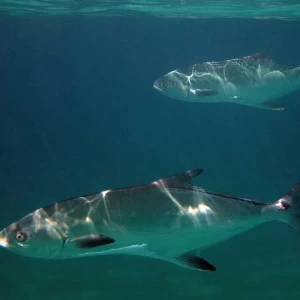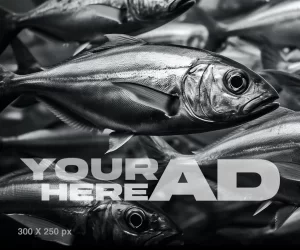Common Names
English: Vadigo, Lexa
Turkish: Çıplak
Size
Average Size: 30-40 cm
Maximum Size: Up to 60 cm
Scientific Classification
Kingdom: Animalia
Phylum: Chordata
Class: Actinopterygii
Order: Perciformes
Family: Carangidae
Genus: Campogramma
Species: Campogramma glaycos
Vadigo Fish Appearance
Steel blue to green upper body extending midway down the side, terminating in a series of zig-zagging lobes. Ventral color is silver to white. All fins are hyaline to grey, except the caudal fin which is often yellowish. Elongate, moderately deep, and slightly compressed body.
Dorsal profile is more convex than the ventral profile. Upper jaw is broad and rounded, featuring large, widely spaced canine teeth. Typically grows to 60 cm (24 in), with some reports up to 65 cm (26 in). Maximum published weight of 2.8 kg (6.2 lb). Similar in form to queenfish (Oligoplites) and leatherjacks (Scomberoides).
Distinguishing Features: Zig-zagging pattern on the sides, yellowish caudal fin, large canine teeth.
Vadigo (Campogramma glaycos), is a fascinating coastal marine fish that belongs to the jack family, Carangidae. You can find this species predominantly in the eastern Atlantic Ocean, with its range extending from the British Isles all the way down to Senegal, including the western Mediterranean Sea. However, the vadigo has been recently reported also in other parts of the Mediterranean and Aegean seas.
Conservation Status:
Understanding the taxonomy and naming of the vadigo fish can deepen your appreciation for this species. It is the sole representative of the monotypic genus Campogramma and is part of a larger family that includes jacks, horse mackerels, and pompanos. Initially classified under the genus Centronotus in 1801 by Bernard Germain de Lacépède, the vadigo was moved to its present genus Campogramma by Charles Tate Regan in 1903. If you ever come across the terms big-toothed pompano, zippered pompano, lexa, or lexola, know that they all refer to the same species.
As far as the physical description of the Vadigo, you will notice its similarity to other carangids, such as queenfish and leatherjacks. Typically, this fish can grow to about 60 cm (24 in), with some reports suggesting it can reach a length of up to 65 cm (26 in). They have a moderately deep and slightly compressed body, with a dorsal profile that is more convex than the ventral profile.
The vadigo’s upper jaw is broad and rounded, featuring large, widely spaced canines that make it an efficient predator of smaller schooling fish. In terms of coloring, you can identify this species by its striking steel blue to green upper body that transitions to a silver or white ventral side.
Ecological Role
Pelagic predator.
Diet: Primarily smaller schooling fish, thanks to its large canine teeth.
Reproduction: Single spawning event each year with pelagic eggs that float in the water.
Recreational Fishing
Occasionally caught by recreational fishermen. Not actively targeted due to its relative rarity. Valued catch among recreational anglers. Caught on live baits and fishing lures.
Most abundant in the Mediterranean between July and September.
Is Vadigo a Game Fish?
Yes, considered a fine sports fish.
Regulations and Ban
Fishing is open all year round without any specific regulations, but remember that 5 kg per person rule still apply.
Habitat and Distribution
Found in marine waters. Distribution includes the Mediterranean Sea, therefore may occur along the Turkish coasts of the Mediterranean and Aegean.
Typically resides in shallow waters ranging from 15 to 30 meters deep. Moves closer to coastal areas during summer months.
Campogramma glaycos thrives in the Mediterranean, often residing in shallow waters ranging from 15 to 30 meters deep. During summer months, they tend to move closer to coastal areas. This habitat preference not only supports their feeding needs but also facilitates their reproductive cycle, which is still not fully understood. You might find it interesting that the vadigo is known to have a single spawning event each year, with pelagic eggs that float in the water.
In terms of biology and fishery, vadigo fish plays an important role in its ecosystem as a predatory fish. Recreational fishermen consider them a valuable catch, especially during the peak months of July to September in the Mediterranean when they are most abundant. When fishing for vadigo, you can use a variety of baits or lures to increase your chances of a successful catch.
Best Time to Fish
| Month | Fishing Quality |
|---|---|
| January | Low |
| February | Low |
| March | Low |
| April | Moderate |
| May | Moderate |
| June | Good |
| July | Great |
| August | Great |
| September | Good |
| October | Moderate |
| November | Low |
| December | Low |
Best Time of Day: During daylight hours.
Water Temperature Considerations: More active in warmer months.
Quick Facts
| Common Names (English) | Common Names (Turkish) | Size | Habitat | Conservation Status |
|---|---|---|---|---|
| Vadigo, Big-toothed pompano, Zippered pompano, Lexa and Lexola | Çıplak | Up to 65 cm | Shallow coastal waters | Least Concern (LC) |














